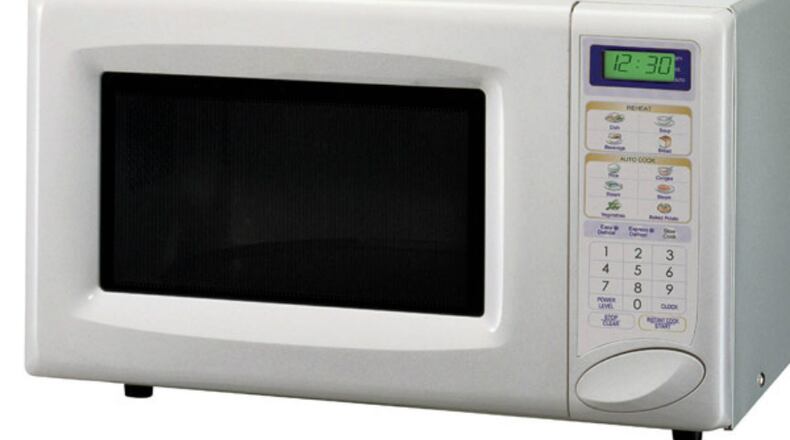Microwaves are a standard appliance in most kitchens nowadays, but it wasn’t always that way.
The world’s first commercial microwave, the futuristically named Radarange, was invented by an engineer at Raytheon and hit the market in 1947. Standing nearly 6 feet tall, weighing more than 750 pounds and using about 3,000 watts of power, it was a beast of a machine that sold for between $2,000 and $3,000.
The first model for residential use was introduced by Tappan Corp. in 1955. At $1,300, this compact machine was a luxury few households could afford. It wasn’t until the 1970s, when parts became cheaper and advances in technology lowered the costs, that microwave purchases surged. By 1986, 25% of American households owned a microwave. Since 1997, that figure has hovered around 90%.
My family wasn’t among those statistics. When my mom and dad planned a kitchen renovation in the early ‘80s, they had the contractor build a space in the wall for one of these cutting-edge gizmos. But after reading scary stories about radiation, my mom had the contractor turn the hole in the wall into a telephone cubby. That was the end of any further talk of a microwave in her home. It lasted that way until we sold the family home a couple of years ago.
Folks who did welcome the microwave with open arms weren’t necessarily aware of all the ways they could put this time-saving, space-saving device to work. (Sound familiar, Instant Pot early adopters?) And that’s when the AJC came to the rescue of home cooks.
In June 1985, the newspaper launched a column called “Microwaving With Ease” with the goal of introducing “the experienced and inexperienced microwave cook to new ideas, methods and recipes designed to meet the needs of today’s fast-paced lifestyles.” The column ran weekly though 1988 and was written by Atlanta-based freelance contributor Ann Tretiak.
The bio that published with the column outlined why Tretiak was the perfect person to unravel the mysteries of the microwave. She was “an experienced microwave cook and writer, who has extensive experience developing and testing recipes and procedures for major microwave and microwave-convection ovens and has contributed to the publication of numerous microwave brochures and cookbooks. She is a graduate in home economics from the University of Georgia and former Consumer Affairs Manager for Reynolds Metals Company.”
“Getting the most out of your microwave oven is the name of the game,” Tretiak wrote in her inaugural column. “Venture past using your microwave for boiling water, melting butter, cooking bacon and baking potatoes. Microwave cookery is ideal for simple food preparation tasks, and an important part of the total picture.”
Her tips for a microwave meal included the following:
- “Planning a complete microwave oven meal takes organization. First, determine how much cooking and standing time various foods require in your menu. Next, consider whether the food will cook quickly, whether it can be reheated easily and if the cooking time can be divided into segments.”
- “Make foods ahead when possible. Plan a chilled menu item to accompany your meal or foods that reheat well since microwaving can re-create a fresh-cooked taste.”
- “Plan to cook foods which have the longest cooking time first.”
- “Meats and casseroles retain heat longer and standing time tends to enhance flavors. Plan to cook these dishes before cooking vegetables or other side dishes.”
Breasts of Chicken Cordon Bleu was one of the three recipes included in the first “Microwaving With Ease” column. A microwave chicken dinner isn’t necessarily a mainstream way to prepare chicken today, but it was revolutionary 40 years ago.
Credit: AJC archives
Credit: AJC archives
Breasts of Chicken Cordon Bleu
- 4 chicken breast halves, boned and skinned, about 1 1/2 pounds
- 4 slices fully cooked ham, thinly sliced, about 1/4 pound
- 4 slices Swiss cheese, thinly sliced, about 1/4 pound
- 2 tablespoons butter or margarine
- 1/3 cup corn flake crumbs
- 1/4 grated Parmesan cheese
- 1/2 teaspoon dried parsley flakes
- 1/2 teaspoon paprika
- Pound chicken with flat side of meat mallet to 1/4-inch thickness. Place 1 slice of ham and Swiss cheese on each chicken half. Roll up, jelly-roll style, starting from short side. Arrange chicken in an 8-by-8-inch baking dish spoke-fashion, with seam-side down and thickest part toward outside of dish. Place butter in custard cup. Microwave at HIGH (100%) 25 to 35 seconds. Brush each chicken breast with melted butter.
- Make the crumb coating: In a small bowl, combine the corn flake crumbs, Parmesan cheese, parsley flakes and paprika. Sprinkle 1 to 2 tablespoons crumb mixture over each breast. Cover chicken with wax paper, securing with wooden toothpick, if necessary. Microwave chicken at HIGH (100%) 9 to 14 minutes or until no longer pink, rotating and rearranging chicken once. Let stand, covered, 5 to 10 minutes to complete cooking.
Serves 4.
Per serving: 438 calories (percent of calories from fat, 47), 54 grams protein, 3 grams carbohydrates, 2 grams total sugars, trace fiber, 22 grams total fat (12 grams saturated), 161 milligrams cholesterol, 623 milligrams sodium.
Archival research contributed by Pete Corson.
Sign up for the AJC Food and Dining Newsletter
Read more stories like this by liking Atlanta Restaurant Scene on Facebook, following @ATLDiningNews on X and @ajcdining on Instagram.
About the Author
Keep Reading
The Latest
Featured





